
United States Department of the Interior
OFFICE OF THE SECRETARY
Washington, DC 20240
OCIO Directive 2020-003
To: Assistant Secretaries
Heads of Bureaus and Offices
From: Bruce M. Downs
Chief Information Officer (Acting)
Subject: Digital Signature Policy
Purpose
This directive establishes a Department of the Interior (DOI, Department) standard and
guidelines for signing electronic documents with digital signatures. A digital signature provides
a high level of assurance that the claimed signatory signed the electronic document. Documents
that traditionally required notarization or wet signatures require this level of assurance.
Applicability
Currently, agencies should use digital signatures for documents that require high levels of
assurance, or for convenience in lower-risk electronic documentation. This policy focuses on the
use of digital signatures to provide higher levels of assurance and trustworthy records.
Background
The 21st Century Integrated Digital Experience Act (IDEA) (Public Law 115-336) and Office of
Management and Budget (OMB) Memorandum M-19-21, Transition to Electronic Records,
direct federal agencies to ensure that they create, retain, and manage all records in electronic
format.
The National Institute of Standards (NIST) issues Federal Information Processing Standards
(FIPS) as part of the Federal Information Security Management Act (FISMA) of 2002, and these
standards are compulsory for federal agencies. Digital signature implementations must comply
with the FIPS 186-4, Digital Signature Standard.
Policy
The Department’s Digital Signature Standard is comprised of using DOI Access Cards (PIV
Cards) to apply digital signatures as the authorized digital signature method. The following
bullets describe how DOI will apply this standard:
1. Using Digital Signatures within DOI. DOI requires personnel to use authorized digital
signature methods to electronically sign documents involving transactions that require
high levels of assurance (such as agreements and forms involving funds, contracts, or
other documents that commit the Department to some form of legal liability).
2. Using Digital Signatures with External Organizations. DOI personnel may use
authorized digital signature methods to electronically sign documents and forms with
non-federal government organizations contingent on the recipient’s approval of this
Digitally signed by
BRUCE DOWNS
Date: 2020.03.31
10:40:13 -04'00'
March 31, 2020

2
format. DOI personnel may not require non-federal government organizations or
individuals to accept or use digital signatures, therefore, they must accommodate the use
of wet-ink or notarized signatures as appropriate when an external recipient rejects the
digital signature.
3. Exceptions: This policy does not require the use of digital signatures for low assurance
transactions, documents, and forms; therefore, current practices (e.g., using government
email messages) remain acceptable. Alternative digital signature methods may be
acceptable upon approval by the Office of the Chief Information Officer and the Office of
the Solicitor, see Frequently Asked Questions (FAQs) in Attachment 1.
Effective Date
This policy is effective immediately upon the date of signature and supersedes all previous
digital signature policies, guidance, and practices that conflict with the required level of
assurance.
Authorities:
• 15 U.S.C. Chapter 96, Electronic Signatures in Global and National Commerce Act
• Public Law 105-277 Sections 1703-1710, Government Paperwork Elimination Act
(GPEA) (44 USC Section 3504 note)
• Public Law 115-336 21st Century Integrated Digital Experience Act (IDEA)
• OMB Memorandum M-18-21 - Transition to Electronic Records
• NIST Special Publication 800-63-3 - Digital Identity Guidelines
• FIPS 186-4 - Digital Signature Standard (DSS)
Attachments
1. Frequently Asked Questions
2. How to Add a Digital Signature Field to a Portable Document Format (PDF) File
cc: Bureau and Office Deputy Directors
Assistant Secretary Chiefs of Staff
Bureau and Office Chiefs of Staff
Bureau and Office Associate Chief Information Officers
Attachment 1
Frequently Asked Questions
Q: What is an electronic signature vs a digital signature?
A: A digital signature provides authenticity protection, integrity protection, and non-repudiation, but
not confidentiality protection as per NIST 800-63-3. The owner of a private signing key creates a
"digital signature" when they use that key to create a unique mark (the signature) on an electronic
document or file. The recipient employs the owner's public key to validate that the associated
private key generated the signature. This process also verifies that no one altered the document.
An Electronic signature is an electronic sound, symbol, or process, attached to or logically
associated with a contract or other record and executed or adopted by a person with the intent to
sign the record. A digital signature is a type of electronic signature.
Q: What is non-repudiation?
A: Provides proof of delivery to the sender and proof of the sender's identity to the recipient so that
neither party can later deny having processed the data. [NS4009]
● Technical non-repudiation refers to the assurance a Relying Party has that if a public key
validates a digital signature, that the corresponding private signature key made the signature.
● Legal non-repudiation refers to the establishment of possession or control of the private
signature key.
Q: What is digital authentication?
A: Digital authentication is an information system’s process of establishing confidence in
electronically presented user identities.
Q: What are the Identity Assurance Levels (IAL)?
A: Based on their risk profile and the potential harm caused by an attacker making a successful false
claim of an identity, agencies may select from the following three IAL options:
IAL1: An agency does not require linking the applicant to a specific real-life identity. Any
attributes provided in conjunction with the authentication process are self-asserted.
IAL2: Evidence supports the real-world existence of the claimed identity and verifies that the
applicant is appropriately associated with this real-world identity. IAL2 introduces the need
for either remote or physically present identity proofing.
IAL3: Agencies require physical presence for identity proofing. An authorized and trained
representative of the Credentialed Service provider (CSP) must verify identifying attributes.
**NOTE: Find complete definitions of the Identity Assurance Levels in the National Institute of
Standards and Technology (NIST) Special Publication 800-63-3.
Q: What is meant by “low assurance” transactions?
A: In accordance with the NIST requirements, low assurance transactions are those that are lower
risk based on the nature of the transaction. For example, the use of a login name and password
verifies access to a system.
Q: Can I use the DOI Access Card to sign/approve forms from other federal, state, or local
agencies or from members of the public?
A: You can use the DOI Access Card to sign an electronic document if the source organization will
accept the use of the electronic signature. You should verify acceptance of the electronic
signature with the source organization prior to signing the document.

2
Q: How do I digitally sign a document?
A: Many software applications (e.g., Microsoft Word, Adobe Acrobat) support the use of digital
signatures including using the DOI Access Card, but it is important to configure the documents to
prevent changes to a valid, digitally signed document. See Attachment 2 for instructions on
applying digital signatures to PDF documents. Access PIV Usage Guides/Digitally Sign a
Microsoft Word Document for instructions on how to sign Microsoft Word documents.
Digitally signed documents must be locked at signing to ensure the content is not modified.
Q: Can I use Alternative Digital Signature Standards and Methods?
A: If current defined and accepted methods approved for use by DOI are not useable or acceptable in
certain cases DOI personnel may request approval for alternative digital signature standards and
methods. The requesting official must complete a risk assessment with their Bureau or Office
Associate Chief Information Officer (ACIO), or their designee to determine the appropriate identity
assurance level (IAL). This risk assessment will assist in determining the appropriate alternative
methodology to use with external parties that do not have a DOI Access Card, (e.g. the general
public). The Office of the Solicitor must approve all alternative standards.
Q: What is the process for completing a risk assessment to utilize other digital signature
technologies?
A: Using Table 1 below, evaluate the category of transaction you intend to conduct based on the
electronic signature. If the evaluation requires either non-repudiation of the signature, or
authenticity of the document, and the signers do not have a government issued PIV card to apply
a digital signature, then you can select a different technology. Contact your bureau or office
ACIO to determine if your agency already has approved digital signature technologies beyond the
government issued PIV card and if you can use those technologies. If the current technologies are
not acceptable, then your ACIO and staff will assist you in completing the risk assessment with
the OCIO and the Office of the Solicitor to meet your specific needs.
Table 1
Category Relationship
(Internal or
External)
Transaction Value * Minimum Level of
Assurance and
Security
Preferred Method
of Assurance and
Security
1
Intra-agency
(within the
same Federal
agency)
Funds Transfer;
Contracts w/Financial
or Legal Liability;
PII/CUI; and/or Legal
Liability
Password Token
(no digital signature
required; but must
log into and use an
official government
system to execute
the transaction).
(IAL 2)
PIV Card to
authenticate to an
official
government system
(however, no
digital signature
required). (IAL3)
2
Intra-agency
(within the
same Federal
No Funds Transfer; No
Contracts w/Financial
or Legal Liability; No
Self-asserted, and
no security
required. (IAL 1)
Self-asserted, and
no security
required. (IAL 1)

3
Category Relationship
(Internal or
External)
Transaction Value * Minimum Level of
Assurance and
Security
Preferred Method
of Assurance and
Security
agency)
PII/CUI; and No Legal
Liability
3
Inter-agency
(between
Federal
agencies)
Funds Transfer;
Contracts w/Financial
or Legal Liability;
PII/CUI; and/or Legal
Liability
Soft Token or Hard
Token (digital
signature required
on the electronic
document). (IAL 3)
Government issued
PIV card used to
apply a digital
signature to the
electronic
document. (IAL 3)
4
Inter-agency
(between
Federal
agencies)
No Funds Transfer; No
Contracts w/Financial
or Legal Liability; No
PII/CUI; and No Legal
Liability
Self-asserted, and
no security
required. (IAL 1)
Self-asserted, and
no security
required. (IAL 1)
5
DOI and
state/local
government
agencies
Funds Transfer;
Contracts w/Financial
or Legal Liability;
PII/CUI; and/or Legal
Liability
Soft Token or Hard
Token (digital
signature required
on the electronic
document). (IAL 3)
No centralized
technical solution
identified.
6
DOI and
state/local
government
agencies
No Funds Transfer; No
Contracts w/Financial
or Legal Liability; No
PII/CUI; and No Legal
Liability
Self-asserted, and
no security
required. (IAL 1)
Self-asserted, and
no security
required. (IAL 1)
7
DOI and
private
organizations
(contractor,
business,
university,
non-profit)
Funds Transfer;
Contracts w/Financial
or Legal Liability;
PII/CUI; and/or Legal
Liability
Soft Token or Hard
Token (digital
signature required
on the electronic
document). (IAL 3)
No centralized
technical solution
identified.
8
DOI and
private
organizations
(contractor,
business,
university,
non-profit)
No Funds Transfer; No
Contracts w/Financial
or Legal Liability; No
PII/CUI; and No Legal
Liability
Self-asserted, and
no security
required. (IAL 1)
Self-asserted, and
no security
required. (IAL 1)

4
Category Relationship
(Internal or
External)
Transaction Value * Minimum Level of
Assurance and
Security
Preferred Method
of Assurance and
Security
9
DOI and
member of
the general
public
Funds Transfer;
Contracts w/Financial
or Legal Liability;
PII/CUI; and/or Legal
Liability
Soft Token or Hard
Token (digital
signature required
on the electronic
document). (IAL 3)
No centralized
technical solution
identified.
10
DOI and
member of
the general
public
No Funds Transfer; No
Contracts w/Financial
or Legal Liability; No
PII/CUI; and No Legal
Liability
Self-asserted, and
no security
required. (IAL 1)
Self-asserted, and
no security
required. (IAL 1)
* NOTE: Transactions that involve funds, contacts, legal liability, or PII are a higher Transaction
Value. Transactions not involving these items are a lower Transaction Value.
Q: If my bureau or office is already using another form of digital signature, can we continue to
use it?
A: Currently Bureaus and Offices use numerous electronic approval/signature processes that require
review and the development of a risk assessment. Bureaus and offices must complete the risk
assessment within one year of the DOI Digital Signature Policy effective date and obtain approval
from your ACIO and the Solicitor’s Office. If the risk assessment indicates that the system poses
an acceptable level of risk, you may continue to use it as is. If the risk assessment shows an
unacceptable level of risk, you must develop a plan of action and milestones to update the process
to an approved method with an acceptable level of risk.
Q: When is this policy effective?
A: This policy is effective immediately upon the date of signature.

Attachment 2
How to Add a Digital Signature Field to a
Portable Document Format (PDF) File
IMPORTANT: Please ensure the PDF file that you are digitally signing is compliant with the
Section 508 of the Rehabilitation Act, as amended.
1. In Adobe Acrobat Pro DC, open the PDF.
2. Click the Tools tab and under Prepare Form, click Open.
3. At the screen stating: “Select a file or scan a document to begin” Adobe should already
display the file you opened at Step 1. If you need to change the file, then click on
“Change File” and browse to the correct file.
• Do not check the box next to: “This document requires signatures” (it
changes which signature field options are available).
• Change the Form Field auto detection to OFF by clicking
“Change” and unchecking the last box in General for: “Automatically detect
form fields,” especially if the files you are adding the digital signature field to are
not forms. If you choose to keep the “Form field auto detection is ON” you may
get form fields detected in error. If this happens, click on the fields you do not
need and delete them. Do not leave fields that you do not need in the file because
this will affect accessibility and compliance with Section 508 of the
Rehabilitation Act.
• You may get a message: No form fields detected. This is fine, especially if the
document is correspondence or the file is not a form.
4. Click Start.
5. On the Prepare Form ribbon over the top of the document, click the icon for Add a
digital signature.
6. Your mouse will turn into a box for you to Left mouse click > Drag a box > Release
(this is where you want the digital signature in your file).
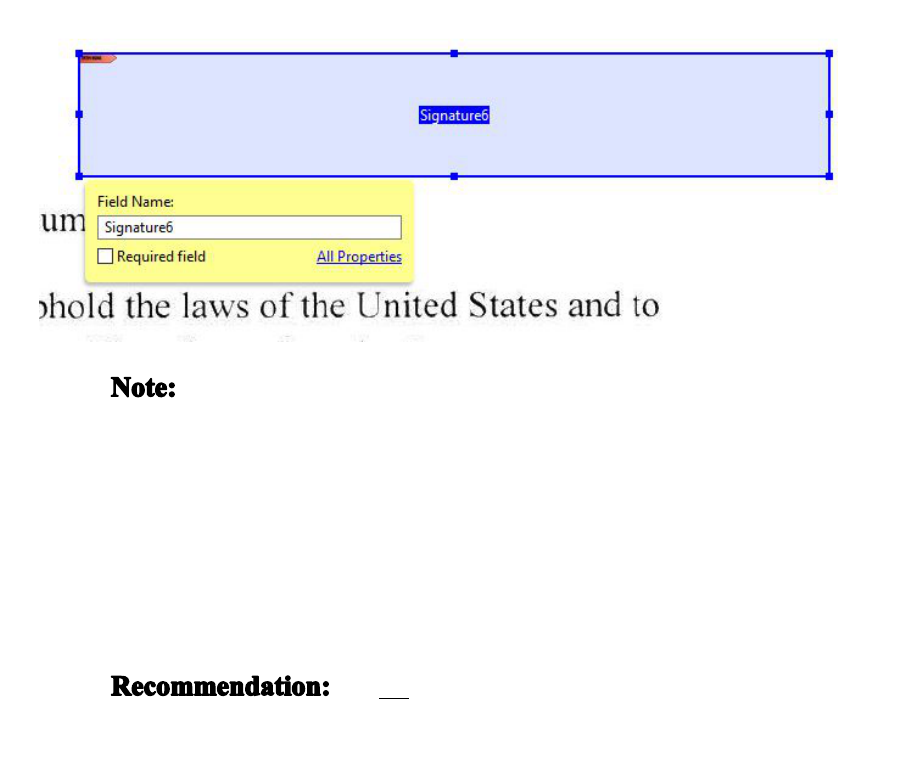
2
• If you have more than one signature in your file, you must give each
digital signature field a unique name. Check the box next to: “Required field” if
applicable, and type “[Person’s Name] Signature” in the Field Name. Click on
the “All Properties” hyperlink. Enter “[Person’s Name] Signature” in both the
Name and Tooltip fields on the General Tab. Hit the enter key.
7. Click Preview to see what the digital signature field looks like for your recipient. If you
want to edit the field, click Edit and you will return to the editing screen. If you are
satisfied with the location and size of the box, then from the Preview or Edit screen, you
may save the file.
• Do not overwrite your original file. Change the filename
and save a separate file.
8. Congratulations, you prepared your PDF file for digital signature!
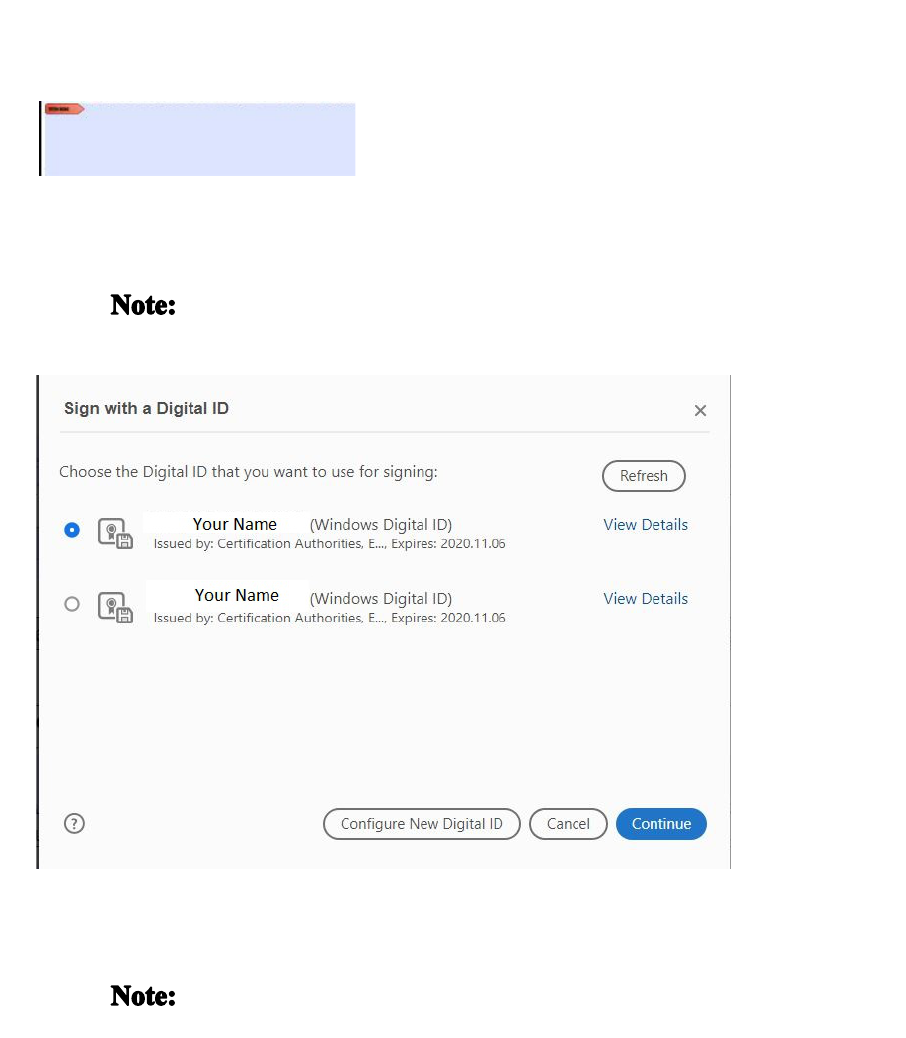
3
How to Digitally Sign a Portable Document Format (PDF)
IMPORTANT: Please ensure the PDF file that you are digitally signing is compliant with the
Section 508 of the Rehabilitation Act, as amended.
Option 1 (Preferred): To sign a PDF document that has a signature field,
perform the following:
1. In Adobe Acrobat Reader or Pro DC, open the PDF you would like to sign.
2. Click the field that has the red sign here flag.
3. In the Sign with a Digital ID window, select by clicking on the digital signing certificate
you would like to use, then click Continue (default is usually correct).
• If there are no digital signing certificates available, then double-check that
you inserted your PIV Card into your laptop or computer.
4. In the “Sign as [Name]” page of the wizard, click Sign.
• If you are the last person digitally signing the document, please check the
“Lock document after signing” box. This step is critical to ensure content is
not modified once the document is signed.
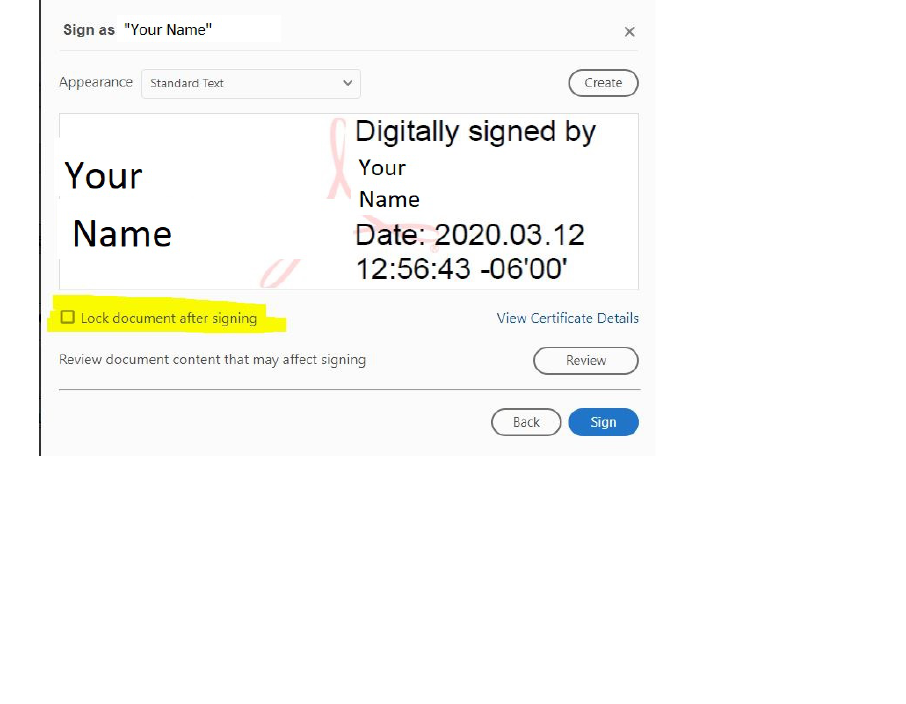
4
5. After you click Sign a pop-up window will appear to save your newly signed PDF file.
You may overwrite the original file or add “Signed” to the filename, but you will need to
save the signed file.
6. After saving the file, you may open it up you. Your digital signature will be in the
location you added the box for signing.
7. Congratulations, you have just digitally signed your PDF file!
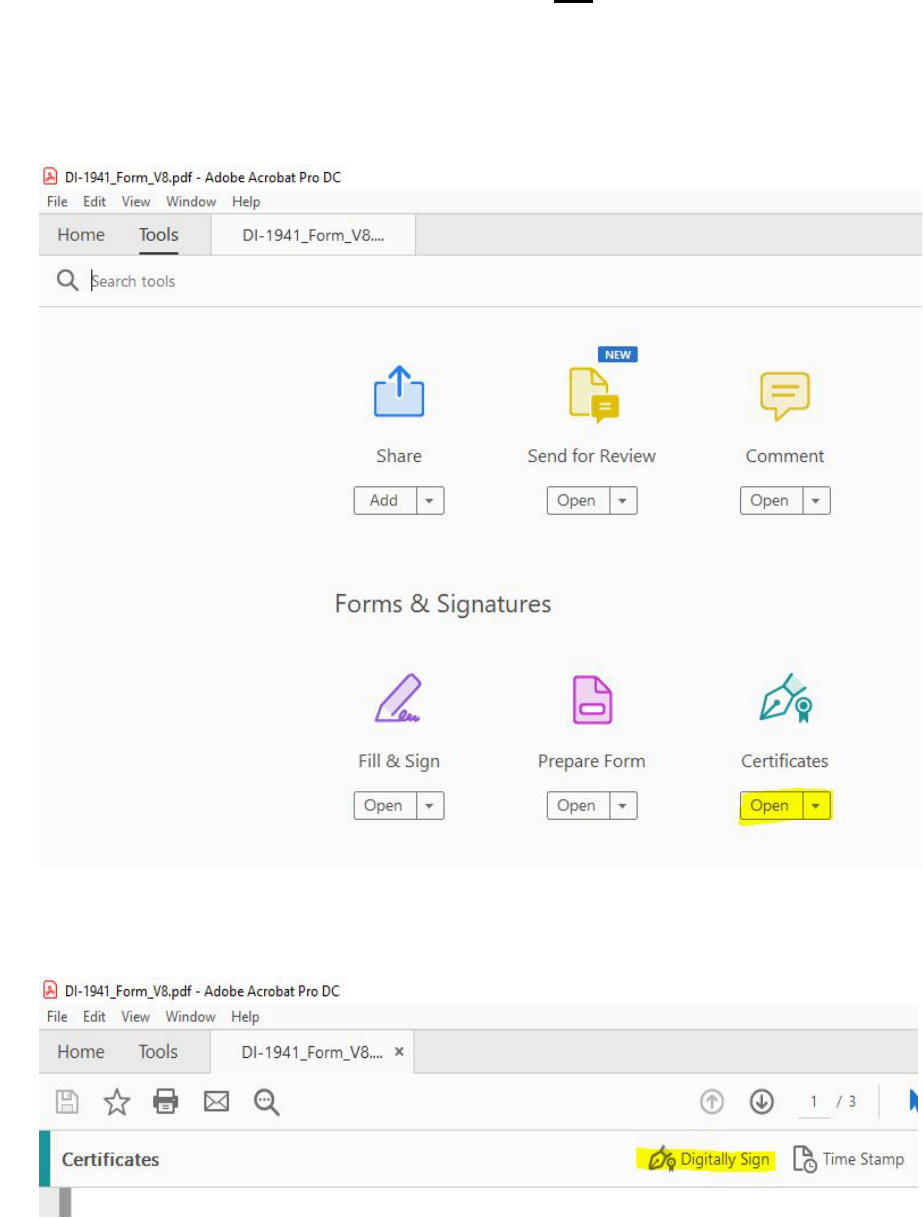
Option 2: To sign a PDF document that does not have a signature field,
perform the following:
1. In Adobe Acrobat Reader or Pro DC, open the PDF you would like to sign.
2. Click the Tools tab and under Certificates, click Open.
3. On the Certificates ribbon over the top of the document, click the icon for Digitally
Sign.
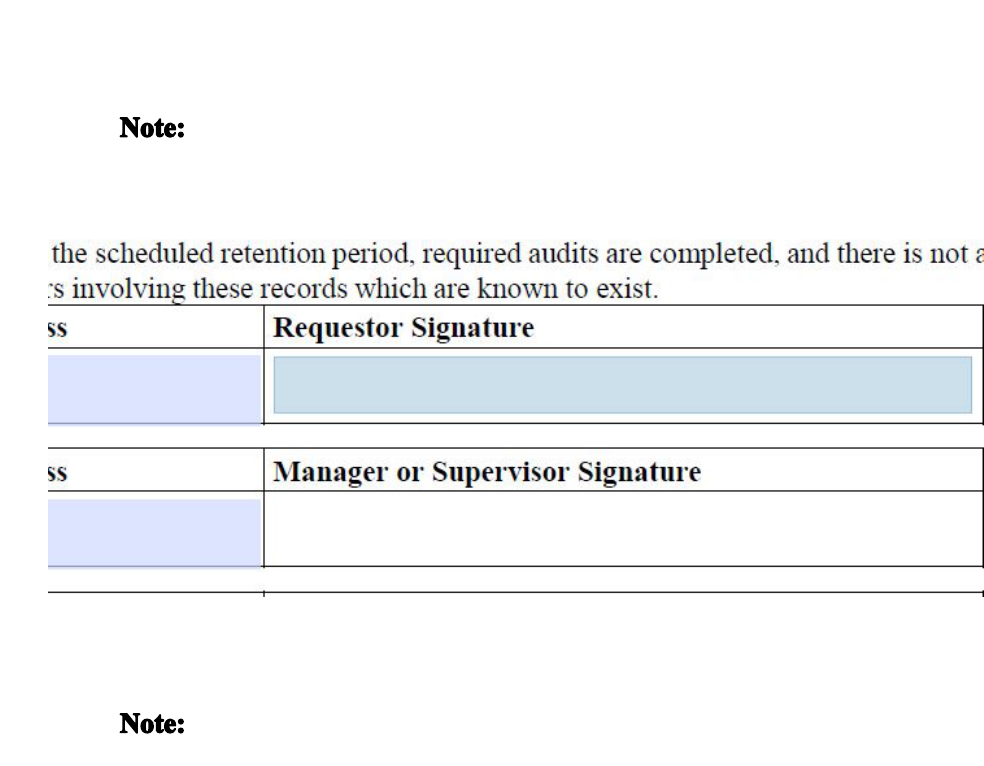
6
4. Using your mouse, click and drag to draw an area where you would like the signature to
appear on the correspondence or in the form. Once you finish dragging out the desired
area, Adobe will take you to the next step in the signing process.
• In the example below, I drew out a box area in the Requestor Signature
box (anywhere will do). Left mouse click > Drag a box > Release
5. In the Sign with a Digital ID window, click on the digital signing certificate you would
like to use, then click Continue (default is usually correct).
• If there are no digital signing certificates available, then double-check that
you inserted your PIV Card into your laptop or computer.
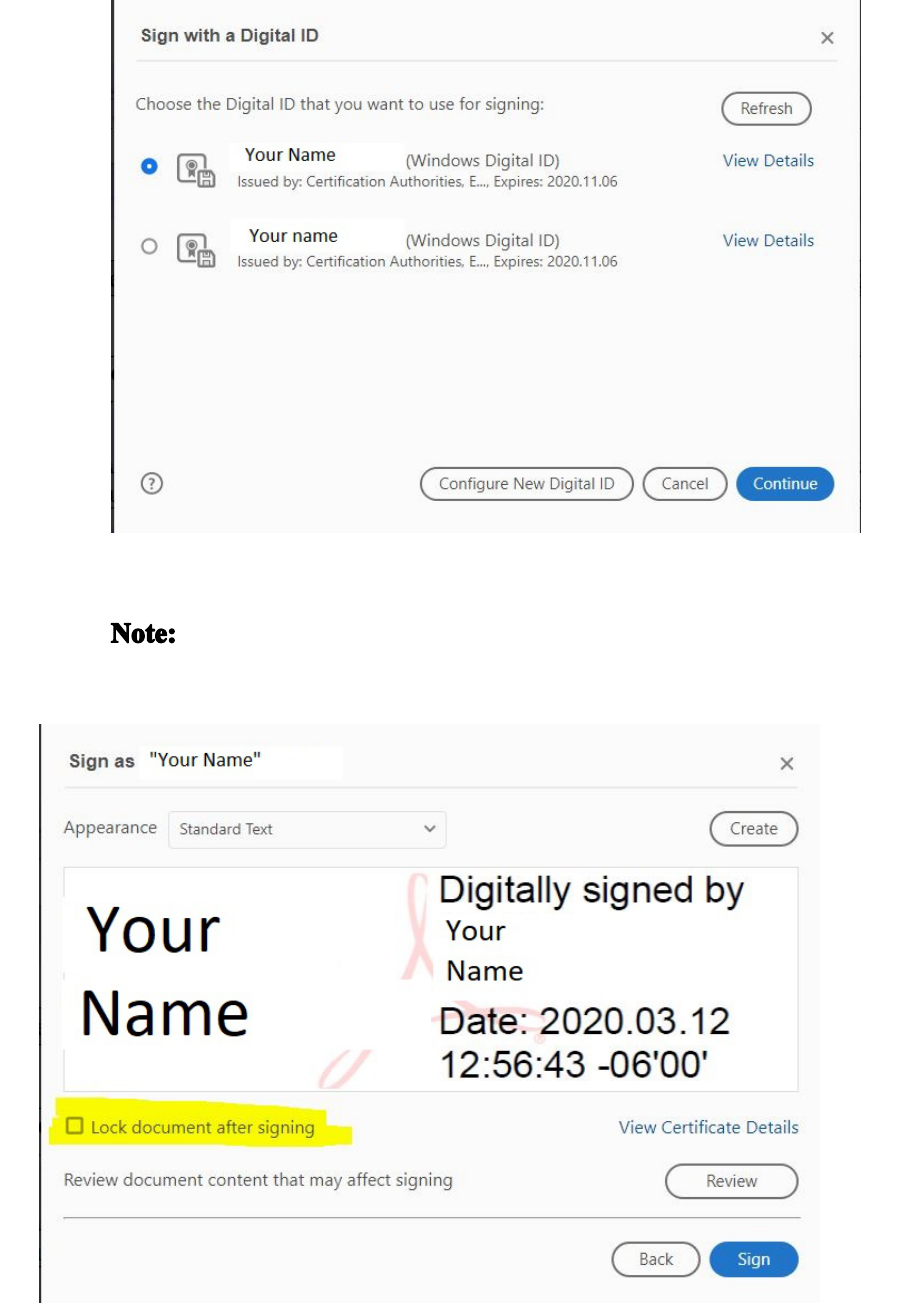
7
6. In the Sign as page of the wizard, click Sign.
• If you are the last person digitally signing the document, please check the
“Lock document after signing” box. This step is critical to ensure content is
not modified once the document is signed.

8
7. After you click Sign you should get a pop-up window to save your newly signed PDF
file. You may overwrite the original file or add “Signed” to the filename, but you will
need to save the signed file.
8. After saving the file, you may open it up you. Your digital signature will be in the
location you drew the box for signing.
9. Congratulations, you have just digitally signed your PDF file
